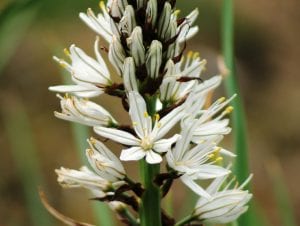The Mediterranean Basin of Europe and North Africa display comprises plants displayed according to vegetation biomes found in this region.
The evergreen forest biome is planted with evergreen oaks, including holm oak Quercus ilex and cork oak Quercus suber. These are under planted with a shrub layer of rue Ruta graveolens, Teucrium fruticans ‘Azureum’ and Ruscus aculeatus. Open planting representing forest clearings is home to cardoon Cynara carduculus, Paeonia mascula and many bulb species.
Maquis or macchie is very dense thickets of shrubs represented by tree heather Erica arborea, Phlomis fruticosa inter planted with bulbous species, Sternbergia lutea and Cyclamen repandum. A stone pine Pinus pinea grows above the shrub layer under planted with cistus Cistus monspeliensis representing cistus maquis. Plantings of carob Ceratonia siliqua, fan palm Chamaerops humilis and Myrtus communis represent carob-myrtle and carob-palm maquis.
A rocky landscape is home to a display of garigue, dominated by vertical spikes of Italian cypress Cupressus sempervirens ‘Green Pencil’ planted with lavender Lavandula angustifolia, sage Salvia officinalis and Thymus sp. Plants showing extreme morphological adaptation to a dry environment; Euphorbia rigida, Onopordum acanthium and Convolvulus cneorum can be seen growing amongst the rocks. Many bulbous species are displayed including fly pollinated Arum creticum, A. palestinum and Biarum tenuifolium. In spring the yellow flowered Asphodeline lutea and the deep blue heads of the bulbous Scilla peruviana flower underneath tall spikes of giant fennel Ferula communis reach up to 2.5m.
Steppe is highly degraded habitat where tree and shrub cover has been removed. Home to deep rooted perennials: Asphodelus albus, Eremurus stenophyllus and annuals including Silybum marianum. The abundance of surface rock and open stony ground indicate the overgrazed and sparse nature of this habitat.
For over ten thousand years man has been clearing the natural vegetation of the European Mediterranean Region and domesticating its plants. Part of the display showcases many of the domesticated plants including: olive Olea europea, pomegranate Punica grantum, cereals, Triticum durum and Avena orientalis. Vines Vitis vinifera, peas Pisium sp. and garlic Allium sativum are grown in a small display representing a vineyard and agricultural field. Orris root, Iris florentina, mastic Pistacia lentiscus and myrtle, Myrtus communis used as fixitives, gums and oils show further the domestication of plants. While marigold, Calendula officinalis, lavender Lavandula angustifolia and chamomile Chamaemelum nobile represent some of the rich herb flora of this region.
The whole display is centred on a raised south facing embankment deliberately built up to improve drainage and capture the maximum amount of solar radiation. A stony path migrates its way through the display allowing visitors to immerse themselves and enjoy the sites and smells of the display. Large rocks of oolitic known locally as Cotswold limestone have been carefully arranged to form natural out crops. These rocks absorb the sun’s energy during day and help warm the display at night so providing special microclimates for many species. A circular stone planter planted with Mediterranean thyme species doubles as a ‘turf seat’. In summer it is full of flower and buzzes with insect activity.

